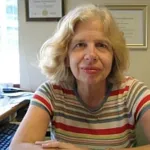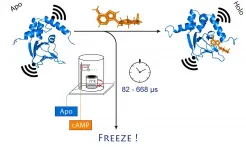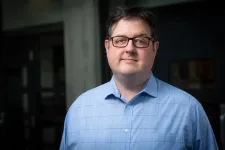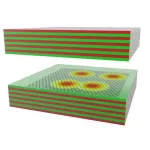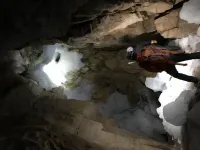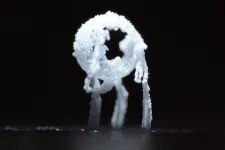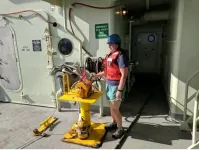(Press-News.org) These mysterious earthquakes originate between 400 and 700 kilometers below the surface of the Earth and have been recorded with magnitudes up to 8.3 on the Richter scale.
Xanthippi Markenscoff, a distinguished professor in the Department of Mechanical and Aerospace Engineering at the UC San Diego Jacobs School of Engineering, is the person who solved this mystery. Her paper " END
UC San Diego engineering professor solves deep earthquake mystery
A University of California San Diego engineering professor has solved one of the biggest mysteries in geophysics: What causes deep-focus earthquakes?
2021-04-28
ELSE PRESS RELEASES FROM THIS DATE:
FSU researchers develop tool to track marine litter polluting the ocean
2021-04-28
In an effort to fight the millions of tons of marine litter floating in the ocean, Florida State University researchers have developed a new virtual tool to track this debris.
Their work, which was published in Frontiers in Marine Science, will help provide answers to help monitor and deal with the problem of marine litter.
Eric Chassignet, director of the Center for Ocean-Atmospheric Prediction Studies and professor in the Department of Earth, Ocean and Atmospheric Science.
"Marine litter is found around the world, and we do not fully understand its ...
Researchers investigate structural changes in snap-frozen proteins
2021-04-28
Researchers at the University of Bonn and the research center caesar have succeeded in ultra-fast freezing proteins after a precisely defined period of time. They were able to follow structural changes on the microsecond time scale and with sub-nanometer precision. Owing to its high spatial and temporal resolution, the method allows tracking rapid structural changes in enzymes and nucleic acids. The results are published in the Journal of the American Chemical Society.
If you want to know what the spatial structure of a biomolecule looks like, you have a formidable arsenal of tools at your disposal. The most popular ones are electron microscopy and X-ray diffraction, which can reveal even the smallest ...
Eye movements of those with dyslexia reveal laborious and inefficient reading strategies
2021-04-28
Researchers have long noted that readers with dyslexia employ eye movements that are significantly different from non-dyslexics. While these movements have been studied in small sample sizes in the past, a new paper written by Concordia researchers and published in the Nature journal END ...
CCNY team makes single photon switch advance
2021-04-28
The ability to turn on and off a physical process with just one photon is a fundamental building block for quantum photonic technologies. Realizing this in a chip-scale architecture is important for scalability, which amplifies a breakthrough by City College of New York researchers led by physicist Vinod Menon. They've demonstrated for the first time the use of "Rydberg states" in solid state materials (previously shown in cold atom gases) to enhance nonlinear optical interactions to unprecedented levels in solid state systems. This feat is a first step towards realizing chip-scale scalable single photon switches.
In solid state systems, exciton-polaritons, half-light ...
Cave deposits show surprising shift in permafrost over the last 400,000 years
2021-04-28
Nearly one quarter of the land in the Northern Hemisphere, amounting to some 9 million square miles, is layered with permafrost -- soil, sediment, and rocks that are frozen solid for years at a time. Vast stretches of permafrost can be found in Alaska, Siberia, and the Canadian Arctic, where persistently freezing temperatures have kept carbon, in the form of decayed bits of plants and animals, locked in the ground.
Scientists estimate that more than 1,400 gigatons of carbon is trapped in the Earth's permafrost. As global temperatures climb, and permafrost thaws, this frozen reservoir could potentially escape into the ...
Cave deposits reveal Pleistocene permafrost thaw, absent predicted levels of CO2 release
2021-04-28
Chestnut Hill, Mass. (4/28/2021) -- The vast frozen terrain of Arctic permafrost thawed several times in North America within the past 1 million years when the world's climate was not much warmer than today, researchers from the United States and Canada report in today's edition of Science Advances.
Arctic permafrost contains twice as much carbon as the atmosphere. But the researchers found that the thawings -- which expel stores of carbon dioxide sequestered deep in frozen vegetation -- were not accompanied by increased levels of CO2 in the atmosphere. The surprising finding runs counter to predictions that as the planet ...
How to get salt out of water: Make it self-eject
2021-04-28
About a quarter of a percent of the entire gross domestic product of industrialized countries is estimated to be lost through a single technical issue: the fouling of heat exchanger surfaces by salts and other dissolved minerals. This fouling lowers the efficiency of multiple industrial processes and often requires expensive countermeasures such as water pretreatment. Now, findings from MIT could lead to a new way of reducing such fouling, and potentially even enable turning that deleterious process into a productive one that can yield saleable products.
The findings are the result of years of work by recent MIT graduates Samantha McBride PhD '20 and Henri-Louis Girard PhD '20 with professor of mechanical ...
Combined recognition strategy allows CAR T cells to kill solid tumors in mice and avoid side effects
2021-04-28
Two teams have created a new generation of highly specific CAR T cells, which safely cleared solid tumors in mice with mesothelioma, ovarian cancer, and the deadly brain cancer glioblastoma while outlasting and outperforming conventional CAR T cell designs. The results suggest these cells could minimize the risk of dangerous side effects and address the traditionally poor performance of CAR T cells against solid tumors in the clinic. CAR T cells are genetically modified human T cells and have shown impressive performance in patients with leukemia. However, CAR T cells don't work as well against solid tumors, as these cancers lack molecular targets that the cells can easily recognize. ...
Category killers of the internet are significantly reducing online diversity
2021-04-28
The number of distinctive sources and voices on the internet is proven to be in long-term decline, according to new research.
A paper entitled 'Evolution of diversity and dominance of companies in online activity' published in the PLOS ONE scientific journal has shown between 60 and 70 percent of all attention on key social media platforms in different market segments is focused towards just 10 popular domains.
In stark contrast, new competitors are struggling to survive against such dominant players, with just 3 percent of online domains born in 2015 still active today, compared to nearly 40 percent of those formed back in 2006.
The researchers say ...
Deep under the ocean, microbes are active and poised to eat whatever comes their way
2021-04-28
The subseafloor constitutes one of the largest and most understudied ecosystems on Earth. While it is known that life survives deep down in the fluids, rocks, and sediments that make up the seafloor, scientists know very little about the conditions and energy needed to sustain that life.
An interdisciplinary research team, led from ASU and the Woods Hole Oceanographic Institution (WHOI), sought to learn more about this ecosystem and the microbes that exist in the subseafloor. The results of their findings were recently published in Science Advances, with ASU School of Earth and Space Exploration assistant professor and geobiologist ...
LAST 30 PRESS RELEASES:
How do childcare tax credits affect children’s long-term health?
Can an electronic nose detect indoor mold?
Do natural disasters have long-term impacts on mortality in older adults?
Modification improves sodium‐ion batteries as an alternative to lithium-ion batteries
Parasports provide a range of benefits for people with cerebral palsy
How does grandparental care affect children’s health?
Why are there so many Nordic mediators?
Young shark species more vulnerable to extinction
Mobile fetal heart monitoring linked to fewer newborn deaths in Tanzania
Bluey’s dad offered professorial chair in archaeology at Griffith University
Beyond small data limitations: Transfer learning-enabled framework for predicting mechanical properties of aluminum matrix composites
Unveiling non-thermal catalytic origin of direct current-promoted catalysis for energy-efficient transformation of greenhouse gases to valuable chemicals
Chronic breathlessness emerging as a hidden strain on hospitals
Paleontologists find first fossil bee nests made inside fossil bones
These fossils were the perfect home for ancient baby bees
Not everyone reads the room the same. A new study examines why.
New research identifies linked energy, immune and vascular changes in ME/CFS
Concurrent frailty + depression likely boost dementia risk in older people
Living in substandard housing linked to kids’ missed schooling and poor grades
Little awareness of medical + psychological complexities of steroid cream withdrawal
Eight in 10 trusts caring for emergency department patients in corridors, finds BMJ investigation
NASA’s Webb telescope finds bizarre atmosphere on a lemon-shaped exoplanet
The gut bacteria that put the brakes on weight gain in mice
Exploring how patients feel about AI transcription
Category ‘6’ tropical cyclone hot spots are growing
Video: Drivers struggle to multitask when using dashboard touch screens, study finds
SLU research shows surge in alcohol-related liver disease driving ‘deaths of despair’
Rising heat reshapes how microbes break down microplastics, new review finds
Roots reveal a hidden carbon pathway in maize plants
Membrane magic: FAMU-FSU researchers repurpose fuel cells membranes for new applications
[Press-News.org] UC San Diego engineering professor solves deep earthquake mysteryA University of California San Diego engineering professor has solved one of the biggest mysteries in geophysics: What causes deep-focus earthquakes?
